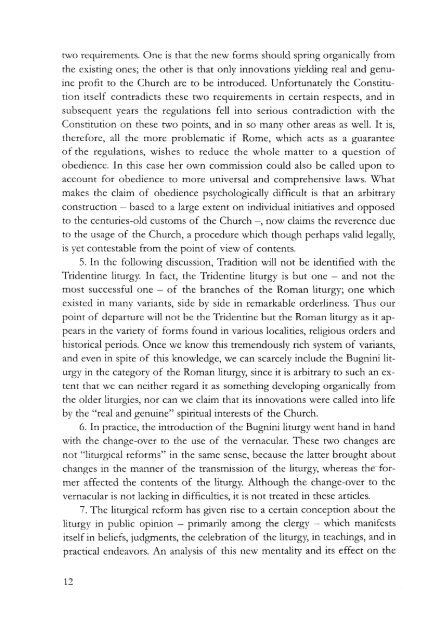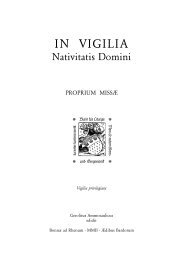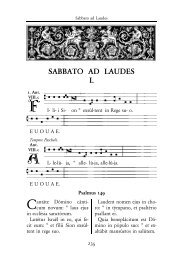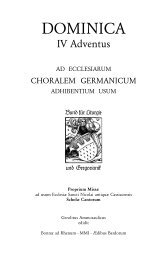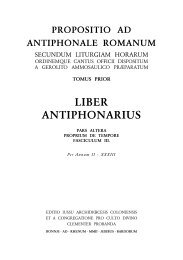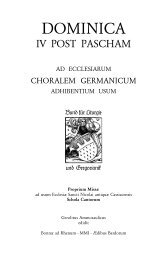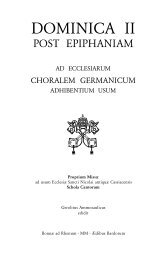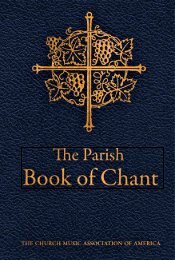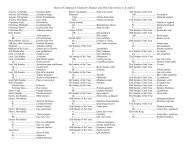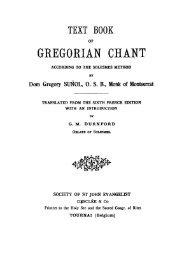The Bugnini-Liturgy and the Reform of the Reform - MusicaSacra
The Bugnini-Liturgy and the Reform of the Reform - MusicaSacra
The Bugnini-Liturgy and the Reform of the Reform - MusicaSacra
You also want an ePaper? Increase the reach of your titles
YUMPU automatically turns print PDFs into web optimized ePapers that Google loves.
two requirements. One is that <strong>the</strong> new forms should spring organically from<br />
<strong>the</strong> existing ones; <strong>the</strong> o<strong>the</strong>r is that only innovations yielding real <strong>and</strong> genuine<br />
pr<strong>of</strong>it to <strong>the</strong> Church are to be introduced. Unfortunately <strong>the</strong> Constitution<br />
itself contradicts <strong>the</strong>se two requirements in certain respects, <strong>and</strong> in<br />
subsequent years <strong>the</strong> regulations fell into serious contradiction with <strong>the</strong><br />
Constitution on <strong>the</strong>se two points, <strong>and</strong> in so many o<strong>the</strong>r areas as well. It is,<br />
<strong>the</strong>refore, all <strong>the</strong> more problematic if Rome, which acts as a guarantee<br />
<strong>of</strong> <strong>the</strong> regulations, wishes to reduce <strong>the</strong> whole matter to a question <strong>of</strong><br />
obedience. In this case her own commission could also be called upon to<br />
account for obedience to more universal <strong>and</strong> comprehensive laws. What<br />
makes <strong>the</strong> claim <strong>of</strong> obedience psychologically difficult is that an arbitrary<br />
construction — based to a large extent on individual initiatives <strong>and</strong> opposed<br />
to <strong>the</strong> centuries-old customs <strong>of</strong> <strong>the</strong> Church -, now claims <strong>the</strong> reverence due<br />
to <strong>the</strong> usage <strong>of</strong> <strong>the</strong> Church, a procedure which though perhaps valid legally,<br />
is yet contestable from <strong>the</strong> point <strong>of</strong> view <strong>of</strong> contents.<br />
5. In <strong>the</strong> following discussion, Tradition will not be identified with <strong>the</strong><br />
Tridentine liturgy. In fact, <strong>the</strong> Tridentine liturgy is but one - <strong>and</strong> not <strong>the</strong><br />
most successful one - <strong>of</strong> <strong>the</strong> branches <strong>of</strong> <strong>the</strong> Roman liturgy; one which<br />
existed in many variants, side by side in remarkable orderliness. Thus our<br />
point <strong>of</strong> departure will not be <strong>the</strong> Tridentine but <strong>the</strong> Roman liturgy as it appears<br />
in <strong>the</strong> variety <strong>of</strong> forms found in various localities, religious orders <strong>and</strong><br />
historical periods. Once we know this tremendously rich system <strong>of</strong> variants,<br />
<strong>and</strong> even in spite <strong>of</strong> this knowledge, we can scarcely include <strong>the</strong> <strong>Bugnini</strong> liturgy<br />
in <strong>the</strong> category <strong>of</strong> <strong>the</strong> Roman liturgy, since it is arbitrary to such an extent<br />
that we can nei<strong>the</strong>r regard it as something developing organically from<br />
<strong>the</strong> older liturgies, nor can we claim that its innovations were called into life<br />
by <strong>the</strong> "real <strong>and</strong> genuine" spiritual interests <strong>of</strong> <strong>the</strong> Church.<br />
6. In practice, <strong>the</strong> introduction <strong>of</strong> <strong>the</strong> <strong>Bugnini</strong> liturgy went h<strong>and</strong> in h<strong>and</strong><br />
with <strong>the</strong> change-over to <strong>the</strong> use <strong>of</strong> <strong>the</strong> vernacular. <strong>The</strong>se two changes are<br />
not "liturgical reforms" in <strong>the</strong> same sense, because <strong>the</strong> latter brought about<br />
changes in <strong>the</strong> manner <strong>of</strong> <strong>the</strong> transmission <strong>of</strong> <strong>the</strong> liturgy, whereas <strong>the</strong> former<br />
affected <strong>the</strong> contents <strong>of</strong> <strong>the</strong> liturgy. Although <strong>the</strong> change-over to <strong>the</strong><br />
vernacular is not lacking in difficulties, it is not treated in <strong>the</strong>se articles.<br />
7. <strong>The</strong> liturgical reform has given rise to a certain conception about <strong>the</strong><br />
liturgy in public opinion - primarily among <strong>the</strong> clergy - which manifests<br />
itself in beliefs, judgments, <strong>the</strong> celebration <strong>of</strong> <strong>the</strong> liturgy, in teachings, <strong>and</strong> in<br />
practical endeavors. An analysis <strong>of</strong> this new mentality <strong>and</strong> its effect on <strong>the</strong><br />
12


